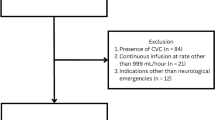Abstract
Objective
To investigate the associated risk factors for ventriculoperitoneal (VP) shunting in infantile hydrocephalus following intraventricular hemorrhage (IVH) in premature infants.
Methods
A historical cohort study was conducted, consisting of 97 premature infants in whom the diagnosis of IVH was previously made by cranial ultrasound and were referred to pediatric neurosurgery clinic and/or neonatal intensive care unit of Children's Hospital Medical Center in Tehran, Iran, from April 2004 to March 2009. Among the patients, those who were followed up for at least 6 months after the diagnosis of IVH were included in the study, and data regarding signs and symptoms of increased intracranial pressure, cranial ultrasound, non-surgical treatment (CSF drainage and/or acetazolamide), and shunt requirement were extracted. Patients who required VP shunting were followed up for at least 6 months thereafter considering shunt infection.
Results
All the patients were followed up for at least 1 year, except for three who died at the ages of 6 (two of them) and 7 months. Thirty five percent (35%) of patients required VP shunting, in all of whom IVH was of grade 3 or 4. The need for VP shunting in these patients was predicted only by the severity of IVH. Non-surgical treatments for IVH had no statistically significant effect on shunt requirement. Moreover, 11 of 31 patients with shunt developed shunt infection, which was significantly associated with repeated cerebrospinal fluid (CSF) drainage.
Conclusion
It is suggested that children with IVH, especially of higher grades, should be followed up meticulously (by signs, symptoms, and periodic cranial ultrasounds). Non-surgical treatments are considered for patients requiring VP shunting who are not good candidates for immediate surgical intervention. The only predictor for surgical intervention was the grade of IVH.
Similar content being viewed by others
References
Bassan H, Limperopoulos C, Visconti K, Mayer DL, Feldman HA, Avery L, Benson CB, Stewart J, Ringer SA, Soul JS, Volpe JJ, du Plessis AJ (2007) Neurodevelopmental outcome in survivors of periventricular hemorrhagic infarction. Pediatrics 120:785–792
Battaglia D, Pasca MG, Cesarini L, Tartaglione T, Acquafondata C, Rando T, Veredice C, Ricci D, Guzzetta F (2005) Epilepsy in shunted posthemorrhagic infantile hydrocephalus owing to pre- or perinatal intra- or periventricular hemorrhage. J Child Neurol 20:219–225
Boynton BR, Boynton CA, Merritt TA, Vaucher YE, James HE, Bejar RF (1986) Ventriculoperitoneal shunts in low birth weight infants with intracranial hemorrhage: neurodevelopmental outcome. Neurosurgery 18:141–145
Gupta AK, Anand NK, Lamba IM (1993) Ultrasonic evaluation of neonatal subependymal-intraventricular hemorrhage and its complications. Indian J Pediatr 60:11–18
Hansen AR, Allred EN, Leviton A (1997) Predictors of ventriculoperitoneal shunt among babies with intraventricular hemorrhage. J Child Neurol 12:381–386
Kadri H, Mawla AA, Kazah J (2006) The incidence, timing, and predisposing factors of germinal matrix and intraventricular hemorrhage (GMH/IVH) in preterm neonates. Childs Nerv Syst 22:1086–1090
Kazan S, Gura A, Ucar T, Korkmaz E, Ongun H, Akyuz M (2005) Hydrocephalus after intraventricular hemorrhage in preterm and low-birth weight infants: analysis of associated risk factors for ventriculoperitoneal shunting. Surg Neurol 64(Suppl 2):S77–81, Discussion S81
Kusters CD, Chen ML, Follett PL, Dammann O (2009) ''Intraventricular'' hemorrhage and cystic periventricular leukomalacia in preterm infants: how are they related? J Child Neurol 24:1158–1170
Luciano M, Pattisapu JV, Wickremesekera A (2004) Infantile post hemorrhagic hydrocephalus. In: Winn HR (ed) Youmans neurological Surgery. Sounders, Philadelphia, pp 3405–3417
Murphy BP, Inder TE, Rooks V, Taylor GA, Anderson NJ, Mogridge N, Horwood LJ, Volpe JJ (2002) Posthaemorrhagic ventricular dilatation in the premature infant: natural history and predictors of outcome. Arch Dis Child Fetal Neonatal Ed 87:F37–F41
Papile LA, Burstein J, Burstein R, Koffler H (1978) Incidence and evolution of subependymal and intraventricular hemorrhage: a study of infants with birth weights less than 1,500 gm. J Pediatr 92:529–534
Resch B, Gedermann A, Maurer U, Ritschl E, Miiller W (1996) Neurodevelopmental outcome of hydrocephalus following intra-/periventricular hemorrhage in preterm infants: short- and long-term results. Childs Nerv Syst 12:27–33
Soul JS, Eichenwald E, Walter G, Volpe JJ, du Plessis AJ (2004) CSF removal in infantile posthemorrhagic hydrocephalus results in significant improvement in cerebral hemodynamics. Pediatr Res 55:872–876
VentriculomegalyTrialGroup (1990) Randomised trial of early tapping in neonatal posthaemorrhagic ventricular dilatation. Arch Dis Child 65:3–10
Volpe JJ (2000) Intracranial hemorrhage. In: Volpe JJ (ed) Neurology of the newborn. Philadelphia: WB Saunders Company, pp 428–493
Watt TJ (1994) Intraventricular hemorrhage in the premature infant. Nebr Med J 79:322–325
Whitelaw A (2001) Intraventricular haemorrhage and posthaemorrhagic hydrocephalus: pathogenesis, prevention and future interventions. Semin Neonatol 6:135–146
Whitelaw A (2001) Intraventricular streptokinase after intraventricular hemorrhage in newborn infants. Cochrane Database Syst Rev, CD000498
Whitelaw A (2001) Repeated lumbar or ventricular punctures in newborns with intraventricular hemorrhage. Cochrane Database Syst Rev, CD000216
Author information
Authors and Affiliations
Corresponding author
Rights and permissions
About this article
Cite this article
Behjati, S., Emami-Naeini, P., Nejat, F. et al. Incidence of hydrocephalus and the need to ventriculoperitoneal shunting in premature infants with intraventricular hemorrhage: risk factors and outcome. Childs Nerv Syst 27, 985–989 (2011). https://doi.org/10.1007/s00381-010-1387-4
Received:
Accepted:
Published:
Issue Date:
DOI: https://doi.org/10.1007/s00381-010-1387-4




